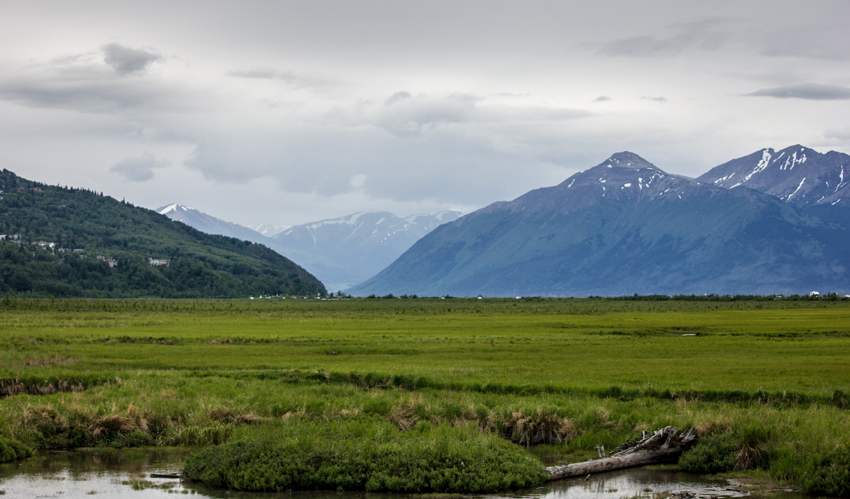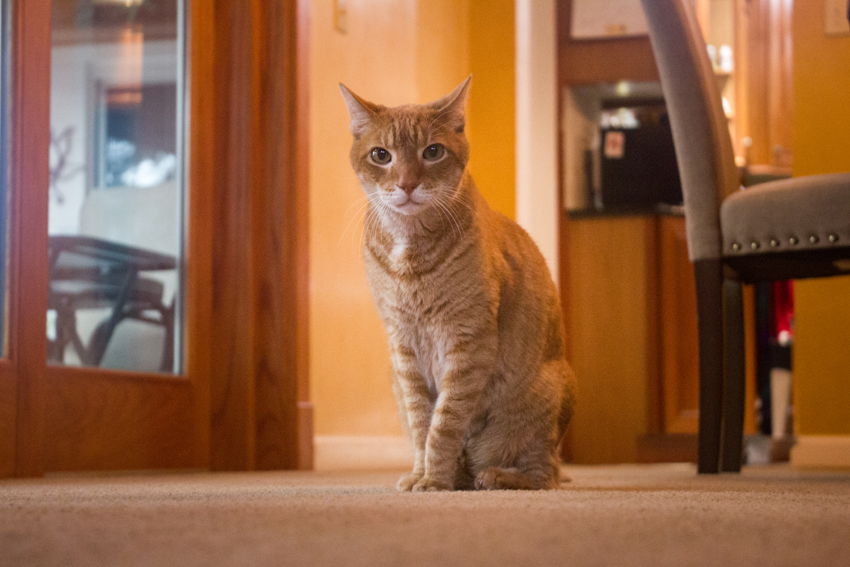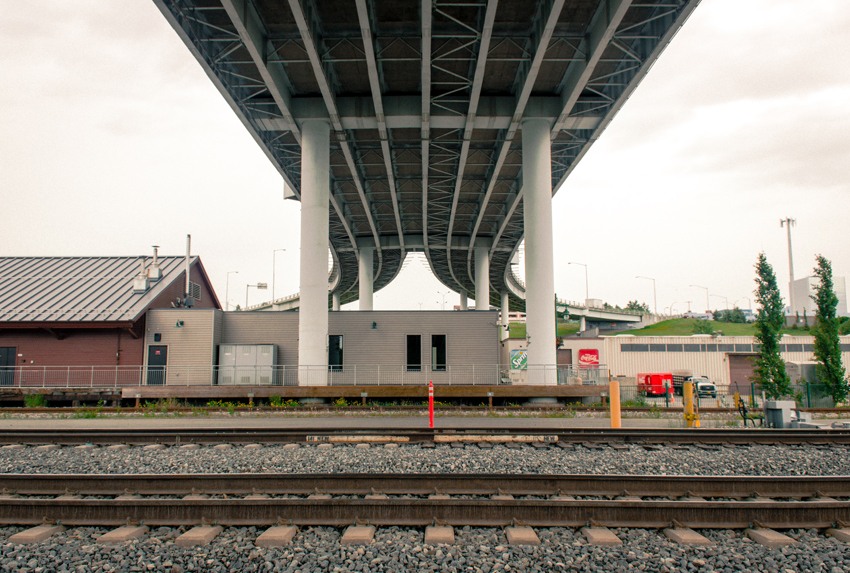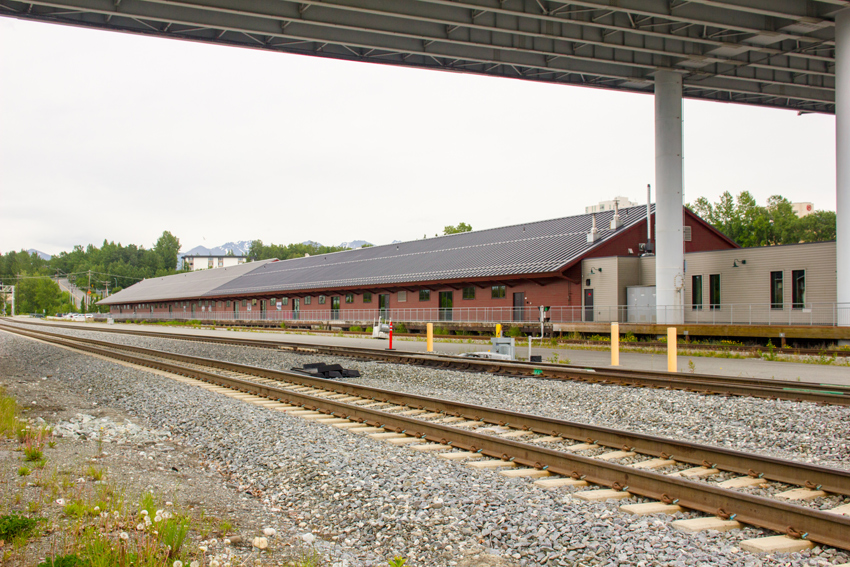A luscious green marshland separates the wildlife viewing boardwalk from the panoramic vista of Turnagain Arm at Potter Marsh in the Anchorage Coastal Wildlife Refuge.
2999 East 154th Avenue, Anchorage, Alaska: Monday, 19 June 2017
part of the Anchorage to Portage Valley album
The Call Of Sweet Sweet Nothing
Montana Secondary Highway 464 winding south through agricultural land in the Blackfeet Indian Reservation.
Near Reference Marker 18.5, Duck Lake Road, Browning, Montana: Tuesday, 03 September 2019
part of the Glacier National Park To Deer Lodge album
The Other Side Of The Rainbow
Red (2007–2020)
Altamonte Springs, Florida: Wednesday, 25 December 2019
part of the Miscellaneous album
I lost someone close to me yesterday. Living with Mom and Ross in Altamonte Springs, Red was a member of our family and was very much loved. He was the sweetest and most gentle cat, even when playing, and will be missed terribly.
Extremely timid by nature, he began to appreciate a more adventurous side over the years. As a travel companion of Mom and Ross, Red has been to more places than me, visiting every state except Hawaii and most provinces of Canada, too. During several of those multi-month road trips, I flew out to locations such as California, Alaska and Montana to meet up for a time. I will never forget the excited look on his face after he jumped off of the bed in the camper — a telltale "thump thump" sound giving him away — to run to the door and then see it was me entering.
He gave that same look whenever I suddenly appeared in his home. I also feel fortunate that he was able to spend time here in Tallahassee, enjoying with me the home that I purchased on Friday, 31 May 2019. Unfortunately, on his most recent visit that started last week, his condition took a turn. He seemed to be trying to tell us something and even spent time on my lap, something he rarely did with me. And then, I was forced to say goodbye to my buddy. Carrying him to the truck, I spoke to him and showed him around the yard, pausing to let him smell some purple flowers.
Cancer may have taken away my sweet kitty before his time, but he will always live on warmly and without pain in my heart.
I love you Red.
The Paper Holds Their Folded Faces To The Floor
The moon at ninety-nine and eighty-two hundredths percent of fullness during the supermoon waxing gibbous phase.
1915 Chuli Nene, Tallahassee, Florida: Tuesday, 07 April 2020
part of the Miscellaneous album
The New Day Will Dawn For Those Who Stand Long
The renovated Alaska Railroad Freight Shed (1941), Coca-Cola Bottling Company of Alaska warehouse buildings (1967) and three Alaska Railroad lines underneath the Anchorage Port Access Bridge (1975) carrying Loop Road, the merging of A Street and C Street, overhead.
150 West Ship Creek Avenue, Anchorage, Alaska: Monday, 19 June 2017
part of the Anchorage album
No visit to Anchorage in June would be complete without a trip to Ship Creek to watch Chinook salmon (Oncorhynchus tshawytscha) on their hatchery-seeded run upstream as well as the sportfishers hoping to catch them. Parking in the Alaska Railroad lot across from the ULU Factory and Comfort Inn, the first thing I noticed was an interesting old building that, while obviously since renovated, looked like it may have once been a depot. I walked to the fence line separating the parking lot from three Alaska Railroad lines running in between my location and the buildings, shot a few photos and then went to the creek.
A depot it was not, but the building in question did serve an important purpose for the railroad. Built in 1941, the Alaska Railroad Freight Shed is a 700-foot-long structure originally constructed "primarily with a heavy timber frame over a raised concrete floor." The freight shed functioned as a central holding facility for the significant amount of goods — "cows, stoves, tractors, almost anything you can think of…" — being shipped by train in Alaska. The facility was a success, allowing Alaska Railroad to double freight tonnage during the first year of operations.
As the years past, the construction of additional roadways throughout the state coupled with regular air cargo flights resulted in an idling of the once bustling shed as freight by rail took a backseat. Used primarily as a storage unit for miscellaneous railroad equipment and customer goods through 2008, the freight shed was thought by some within the railroad to be an "eyesore" and advocated for its demolition.
"Everyone wanted me to tear this [shed] down," said Jim Kubitz, Vice President of Real Estate and Facilities for Alaska Railroad. "It was built like a battleship. It survived the 1964 earthquake." Fortunately, Kubitz was more interested in saving the structure, eligible for the National Register of Historic Places, and looked instead at ways to accomplish the goal of preservation. His solution was to remodel and repurpose the building into a 36,000 square-foot office space, while simultaneously saving the historic structure and renovating it into an energy-efficient one capable of being certified under the Leadership in Energy and Environmental Design (LEED) program.
With coordination and expertise provided to the overall project by the Alaska Office of History and Archeology and its Alaska State Historic Preservation Office, architectural firm ECI/Hyer was hired to develop "a LEED-oriented design that also retained the building's historic nature" and worked on such a design throughout 2008. Following the conceptual, design and final engineering phases, the firms Waterson Construction and Schneider Structural Engineers were awarded contracts as contractor and structural engineer, respectively.
Demolition and interior renovation work began in January 2009, followed by utility and major site work that spring. Although slated to "keep its red siding, two-toned roof and expansive open trusses on the inside," the core and shell renovation work still required the removal of the building's exterior; replacement of all windows with double-paned models; upgrade of lighting to light-emitting diodes; installation of a roof water runoff-to-irrigation system; and the wrapping of the old wooden walls in a one-foot thick layer of insulation. Schneider Structural Engineers described their process thusly.
"Using old-school carpentry materials and techniques, the original handcrafted character was maintained inside and out. The structural challenge was to retain the authenticity of the original framing while accommodating the additional weight of the new building envelope and meeting stringent seismic building code requirements. Schneider added concealed timber 'overframing' and exposed structural steel braced frames without detracting from the cadence of the original timber framing. The result is a modern energy-efficient building, Alaska's first historic building to be reconstructed to meet LEED environmental standards."
Utility work included the relocation of underground electrical service and new gas, water and wastewater connections, while additional accessibility improvements saw the addition of a "raised and heated walkway for pedestrian access and installation of curb and gutter along First Avenue." The core and shell work was completed in November 2009 and all site construction completed in July 2010.
Spared from the wrecking ball, the freight shed formally began its new existence in October 2010 as the first tenant moved in. The Alaska Humanities Forum would remain until January 2018 when they vacated 3,450 square feet. The USDA Forest Service moved to the site in June 2012, which was celebrated on Monday, 27 August 2012 with a ribbon-cutting and awards ceremony with various dignitaries including Anchorage Mayor Dan Sullivan and Senator Mark Begich in attendance. With an office in the area since the early 1900s, the Forest Service had become the largest tenant by moving into the shed the Alaska Region State and Private Forestry office, Chugach National Forest Supervisor's Office and the Pacific Northwest Research Station's Anchorage Forestry Sciences Laboratory.
Following remarks from the politicians and representatives of the Forest Service and Alaska Railroad, the inaugural Colonel Frederick Mears Award of Excellence was given to railroad employees, including Kubitz, and community members who worked on the building's renovation. Named for a former chairman and chief engineer of the Alaska Engineering Commission (1914–1923) who was "responsible for completion of the Alaska Railroad," the award recognizes "people and projects that move the Alaska Railroad forward and contribute to the greater good of Alaska and railbelt community."
Calling the renovated freight shed "a cornerstone of any Ship Creek revitalization plan," the Alaska Railroad proudly announced on Thursday, 21 May 2015 that the Alaska Railroad Freight Shed was awarded Silver LEED Certification, the seventh building to become LEED certified in Alaska. "Preserving and repurposing a historic building helps to maintain a sense of place in the community that is important to future generations," said Kubitz. "The renovation of the freight shed offers Alaska businesses a unique historic and green commercial real estate option in lower downtown Anchorage."
Speaking with The Alaska Contractor, Kubitz also said it has "been gratifying to see the project come together, especially after so many years of trying to figure out how to preserve the building." Able to look at the freight shed from his office nearby, Kubitz said, "I stare at it all day long. It's been really fun to watch it go."
Additional Reading and References
Video: Alaska Railroad Freight Shed (2008-07-14)
PDF: The Alaska Contractor (2009-10)
PDF: Railroad Freight Shed earns Silver LEED status (2015-05-21)
PDF: Alaska Railroad Tenant Newsflash, № 23 (2018-01-12)
PDF: Door 15 Leasing Advert (2019-09-27)












